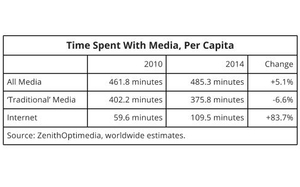The amount of time people spend consuming media continues to expand, raising serious questions about opportunities and consequences for brands competing for consumer attention in an
increasingly fragmented media marketplace. Per capita consumption of media is projected to rise 1.4% this year, to an average of 492 minutes daily, according to estimates released this morning by
Publicis’ ZenithOptimedia unit.
That’s up seven minutes daily from the worldwide per capita average of 485 minutes in 2014, and the media shop’s analysts attribute
it to greater access to the Internet, especially mobile connectivity. Per capita Internet usage will rise 11.8% this year, the agency estimates.
The data, which comes from the latest
edition of ZenithOptimedia’s Media Consumption Forecasts, projects Internet consumption will expand at an average annual rate of 10% between 2014 and 2017, the period being analyzed in the
report.
advertisement
advertisement
Since 2010, the agency estimates per capita usage of the Internet has doubled worldwide from 59.6 minutes to 109.5 minutes daily in 2014.
But like
Newton’s laws of physical gravity, when things go up, some things also come down in the media universe. The amount of time the average global consumer allocated to “traditional
media” -- things like TV, newspapers, radio, magazines and out-of-home media -- declined to 375.8 minutes daily in 2014 from 402.2 minutes in 2010.
“Mobile technology in
particular has created new opportunities to consume media, by allowing people to access the internet while out and about – shopping, commuting to work, waiting to meet friends, and so on,”
says the report.
Currently, ZenithOptimedia estimates the Internet has 22.6% share of time spent with media daily, and will expand to 28.6% in 2017.
“The average person already spends
half their waking life consuming media,” states the report's author, Jonathan Barnard, ZenithOptimedia’s head of forecasting. “But people around the world are clearly hungry for
even
more opportunities to discover information, enjoy entertainment and communicate with each other, and new technology is supplying these opportunities. Technology also enables
brands to communicate with and learn from consumers in new ways. We expect media consumption to continue to grow for the foreseeable future, multiplying the opportunities for brands to
develop relationships with consumers.”
